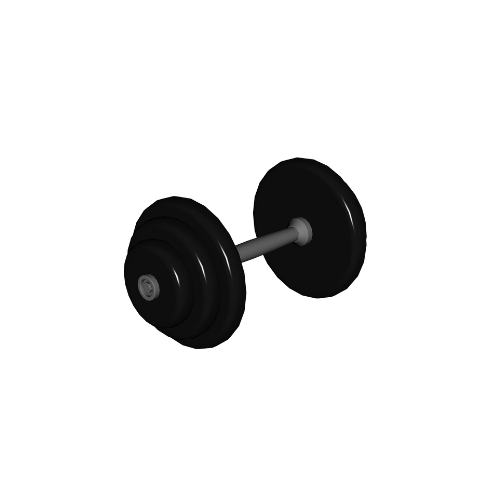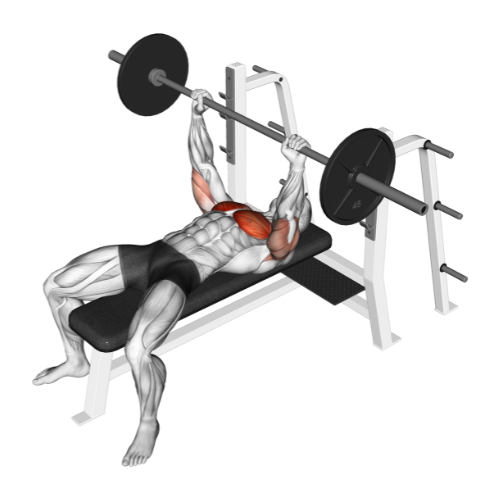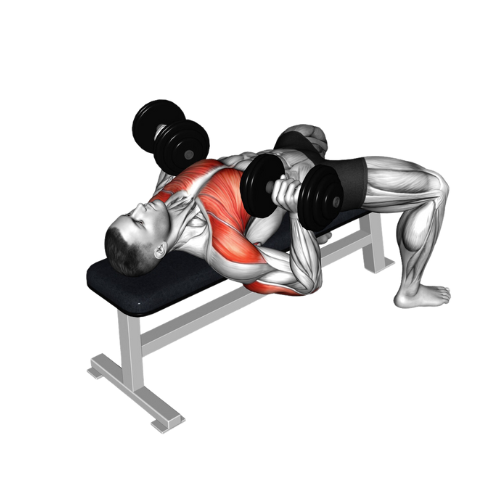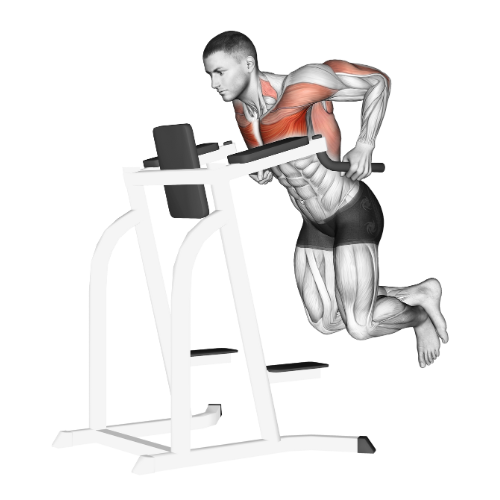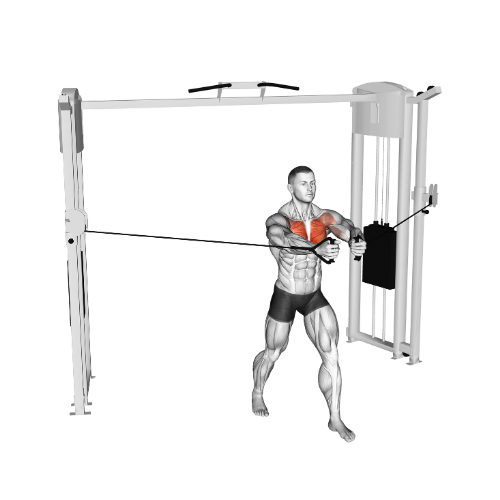Who Should Do?
Bodybuilders
Bodybuilders are at the top of the list of people who should do the decline dumbbell bench press. In a sport that requires a perfectly sculpted, symmetrical chest, this is a go-to movement for any bodybuilding lower chest workout.
This compound chest exercise targets the chest, shoulders, and triceps, making it a must for anyone looking to increase muscle mass.
Regular Gym Goers
The decline dumbbell bench press isn’t reserved for the bodybuilding elite. It’s a great exercise for anyone looking to increase chest mass and add variety to their training.
Many of us will go to the gym and perform the same movements month after month, year after year. Adding an exercise such as the decline dumbbell bench press can keep your program fresh, and help develop a fuller chest.
Strength Training Athletes
Strength training athletes would also benefit from using the decline dumbbell bench press. These athletes primarily perform the squat, bench press, and deadlift.
However, they also use smaller, accessory exercises to target smaller muscle groups to improve their lifts.
While the primary goal of the decline dumbbell bench press is to target the lower chest, its ability to develop shoulder and tricep strength shouldn’t be overlooked. By targeting more muscles, we can increase overall strength and lifting capacity.
Who Should Not Do?
People With Shoulder Injuries
If you suffer from existing or prior shoulder injuries, avoid the decline dumbbell bench press.
The decline bench press places our body and shoulders in a weaker position. This may create discomfort that could aggravate existing or prior injuries.
There are many safer exercises for developing the chest, including the machine chest press, cable press, and dumbbell press.
People With Elbow Pain
The decline dumbbell chest press should be avoided if you suffer from elbow pain. Similar to people with shoulder injuries, the decline angle can place unwanted stress on the elbow.
If you are experiencing elbow pain, consider focusing on rehabilitation exercises to reduce pain and improve function. A flat dumbbell bench press with a light weight or machine chest press may also be suitable. This will allow you to safely target the chest without aggravating your elbows.
Gym Beginners
The decline dumbbell bench press should be avoided if you are an absolute beginner. While it is not a dangerous exercise, the declined bench position can be difficult to press from.
Beginners with no resistance training experience should begin with the dumbbell bench press and incline press to establish the correct technique. Once you feel confident, attempt the decline dumbbell bench press with the help of a trainer or spotter for guidance.
Benefits Of The Decline Dumbbell Bench Press
Boosts Balanced Lower Chest Development
The declined dumbbell bench press is a great dumbbell chest exercise for creating fuller pecs. To get the most out of each rep, use a lighter weight and focus on tensing your lower chest when you press. This will ensure you are correctly activating your lower chest with each rep, stimulating greater growth.
Enhances Shoulder, Tricep, And Serratus Development
Including decline dumbbell bench press into your routine is great for shoulder, tricep, and serratus development.
As an upper-body compound exercise, we can target more muscle groups. This increases our training volume which is shown to enhance muscle hypertrophy.
Improves Physiques
The decline dumbbell bench press’s ability to transform our physique is underrated. Its ability to define the lower pec and create separation from the abdomen enhances our overall chest and core.
Furthermore, its ability to build the shoulders, triceps, and serratus combine to present a more athletic figure.
Add Variety To Workouts
Adding the decline dumbbell bench press is a great way to keep your workouts fresh. Typically, when we create programs, we select the most effective exercise to get the job done.
However, after months and years of training, many exercises can feel stale and overused. Including movements such as the decline dumbbell bench press increases variety. This makes your session feel fresh; leading to greater consistency and success.
Frequently Asked Questions
The decline dumbbell bench press is good for chest development. Used to target the lower chest fibers, the exercise increases muscle mass and greater definition; This results in a fuller-looking chest.
You should avoid the decline bench press if you are a beginner or have shoulder and elbow injuries. The decline position can be uncomfortable for beginners and may place unwanted pressure on the shoulder and elbow.
No, the decline bench press is not the easiest bench press. The decline position is more difficult to set up, and pressing from this position can feel unnatural. If you are a beginner, start on the flat bench.
You can decline bench press without a decline bench by performing a floor press with a glute bridge, or decline cable press. These movements target fibers of the lower chest by changing the angle of the shoulder or torso.
Resources
- Schoenfeld, B.J., Grgic, J., Van, D.W. and Plotkin, D.L. (2021). Loading Recommendations for Muscle Strength, Hypertrophy, and Local Endurance: A Re-Examination of the Repetition Continuum. Sports, [online] 9(2), pp.32–32. doi:https://doi.org/10.3390/sports9020032.
- Solari, F. and Burns, B. (2023). Anatomy, Thorax, Pectoralis Major Major. [online] Nih.gov. Available at: https://www.ncbi.nlm.nih.gov/books/NBK525991/#:~:text=The%20pectoralis%20major%20is%20the,anterior%20wall%20of%20the%20axilla [Accessed 28 Jun. 2024].
- LWW. (2024). Electromyographical Activity of the Pectoralis Muscle… : The Journal of Strength & Conditioning Research. [online] Available at: https://journals.lww.com/nsca-jscr/abstract/1997/08000/electromyographical_activity_of_the_pectoralis.6.aspx [Accessed 28 Jun. 2024].
- Tiwana, M.S., Sinkler, M.A. and Bordoni, B. (2023). Anatomy, Shoulder and Upper Limb, Triceps Muscle. [online] Nih.gov. Available at: https://www.ncbi.nlm.nih.gov/books/NBK536996/ [Accessed 28 Jun. 2024].
- K;Lui, L. (2024). Anatomy, Thorax, Serratus Anterior Muscles. [online] Available at: https://pubmed.ncbi.nlm.nih.gov/30285352/ [Accessed 28 Jun. 2024].
- Lung, K., Kayla St Lucia and Lui, F. (2024). Anatomy, Thorax, Serratus Anterior Muscles. [online] Nih.gov. Available at: https://www.ncbi.nlm.nih.gov/books/NBK531457/ [Accessed 28 Jun. 2024].
- Jeno, S.H. and Varacallo, M. (2023). Anatomy, Back, Latissimus Dorsi. [online] Nih.gov. Available at: https://www.ncbi.nlm.nih.gov/books/NBK448120/ [Accessed 28 Jun. 2024].
- Pritchard, H.J., Barnes, M.J., Keogh, J.W.L. and McGuigan, M.R. (2016). Relationships between 1RM powerlifting competition lifts and common modified and accessory exercises used… [online] ResearchGate. Available at: https://www.researchgate.net/publication/309721659_Relationships_between_1RM_powerlifting_competition_lifts_and_common_modified_and_accessory_exercises_used_in_training_-_a_pilot_study [Accessed 28 Jun. 2024].
- Schoenfeld, B.J., Contreras, B., Krieger, J., Grgic, J., Delcastillo, K., Belliard, R. and Alto, A. (2019). Resistance Training Volume Enhances Muscle Hypertrophy but Not Strength in Trained Men. Medicine and science in sports and exercise, [online] 51(1), pp.94–103. doi:https://doi.org/10.1249/mss.0000000000001764.











